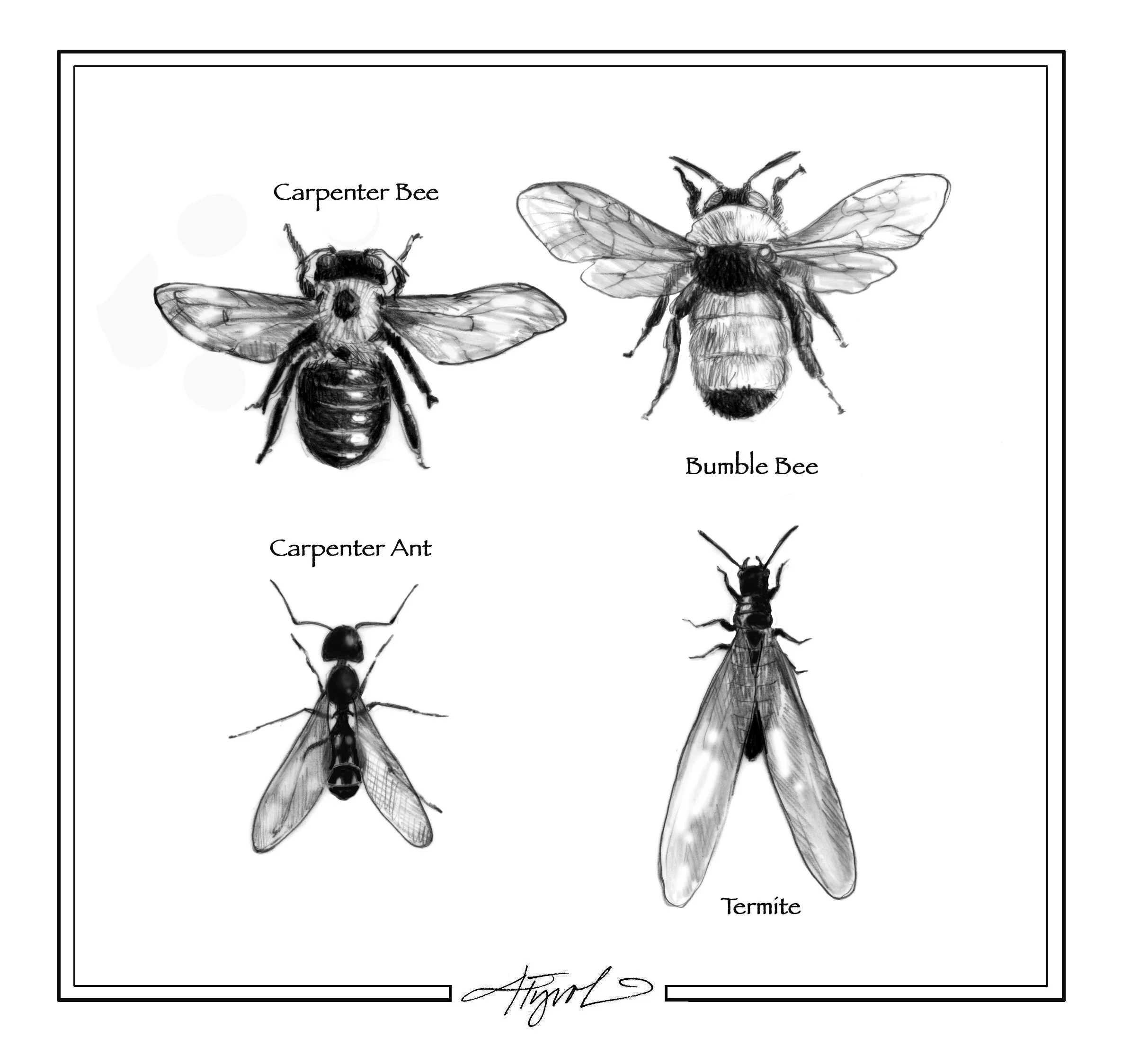The Outside Story: The carpenters arrive in spring
May 3, 2023 | By Jen WeimerIllustration by Adelaide Murphy Tyrol
Why do ants suddenly appear every time spring is near? Just like bees, they long to be close to you – especially if your home is made of wood.
Carpenter ants (genus Camponotus) and the eastern carpenter bee (Xylocopa virginica) both nest in wood and are frequent visitors to my log home. The Northeast is home to one native carpenter bee species and four native carpenter ant species, and these are the largest of the native ants and bees in the region. The carpenters overwinter as adults and become active as the weather warms. As their common name suggests, these insects spend their days constructing – or, rather, deconstructing – wood.
While this can be beneficial to forest decomposition, it is not a desirable trait for our homes.
Carpenter ants excavate nesting chambers in damp and decaying wood, from stumps and rotting logs to dead trees and live, standing trees with rotting interiors. They will also nest in damp wood within human homes.
Individual queens establish colonies by first laying eggs that develop into worker ants. These sterile female worker ants carry food such as insects and honeydew – a sugary excrement of aphids – into the colony to feed the ant larvae of subsequently laid eggs. The queen continues to lay eggs throughout the summer.
Colonies can become large and may last for several years, with adults overwintering in the nest. In spring, winged reproductive males and females emerge and mate. The males die, and the females – or queens – lose their wings and move on to establish new colonies. Parades of worker ants may also move between infested trees and homes as they establish satellite colonies.
Reproductive carpenter ants are winged and are often confused with termites, which also swarm in the spring. You can distinguish them by looking at their abdomens, antennae, and wings. Ants have a constricted waist, elbowed antennae, and their fore and hindwings differ in size, while termites are broad-waisted, with straight antennae and wings that are similar in shape and size. Unlike termites, carpenter ants and bees do not consume wood; they chew into wood for the sole purpose of excavating nests where they lay their eggs.
Carpenter bees are more solitary than ants and prefer to nest in dead, but not rotting, tree limbs and snags – and, sometimes, in non-rotting wood in people’s homes. Fertilized females bore half-inch, perfectly round holes into wood and create chambered galleries where they lay their eggs. Each chamber houses one egg and is provisioned with pollen from spring flowering plants. Carpenter bees are excellent pollinators of garden plants and flowers. They look similar to bumble bees but have a hairy yellow thorax and a hairless abdomen, whereas both the thorax and abdomen are hairy on bumble bees. Carpenter bees are not aggressive and are unlikely to sting.
While both carpenters – bees and ants – play an important role in the forest, where they help to decompose wood and to pollinate plants, their presence in and around our homes can be quite damaging. As carpenter ants remove wood to construct their nests, they can weaken the structural integrity of buildings. While carpenter ants do not kill trees directly, their presence within a tree signifies rot and structural damage. Trees with carpenter ant colonies should be removed to prevent them from falling and damaging nearby structures. Carpenter bee nests are smaller than ant nests and therefore less likely to cause structural damage to trees and homes on their own; however, woodpeckers seeking the bees’ larvae may cause additional damage.
Annual monitoring of your home can help prevent a carpenter infestation. Keep an eye out for holes and sawdust piles on structural wood, including beams, siding, and porches. Remove stumps near buildings, store firewood away from your home, and fix interior water issues to keep your home dry.
Carpenter bees and ants are less likely to bore into wood that has been finished, so protect exterior wood with paint or stain. Removing wood with carpenter bee holes in the spring will eliminate an infestation before the larvae mature.
Gel or liquid sugary bait traps placed along ant trails in the spring also may help to eliminate small colonies of carpenter ants in your home. You can purchase traps for carpenter bees or make traps (basic plans abound online) from simple materials to hang on your home. Insecticides may be warranted if you find structural damage to your home, but be sure to follow the label or contact a professional if colonies are large.
Jen Weimer is a forest health expert, photographer, and writer living in the forests of New Hampshire. The Outside Story is assigned and edited by Northern Woodlands magazine and sponsored by the Wellborn Ecology Fund of the New Hampshire Charitable Foundation.

